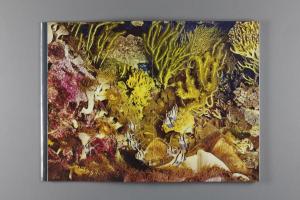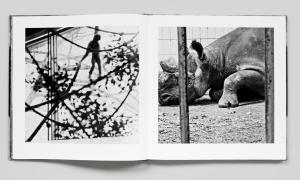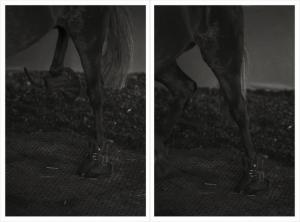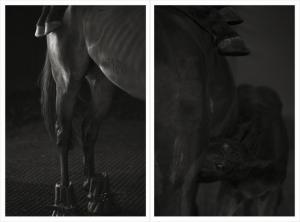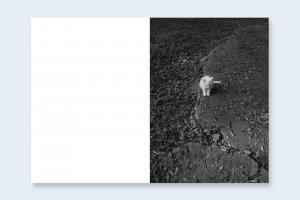»Ape Culture« traces the long cultural and scientific obsession with humanity’s closest relatives. In the Western historical representations of modernity, depictions of apes were traditionally used to show the absence of culture. Standing as a liminal figure separating humans and animals, the ape has, since ancient times, played a central role in the narrative of civilisational progress. This book, which appears in conjunction with the exhibition of the same nameseeks, however, to go beyond the mere examination of apes as signifiers of difference. The juxtaposition of artworks with documents taken from popular culture and the history of primatology gives the reader an insight into what the science historian Donna Haraway has termed the »primate order« — a hall of mirrors reflecting the scientific and cultural projections that turned the ape from an instrument of humanity’s self-definition into an integral element in testing out the possibility of reconstructing human »nature«.
-
-

- Ape Culture
- Anselm Franke & Hila Peleg
- Spector Books
- 2015
→more -
-
-

- Appetite for the Magnificent
- Tania Willen, David Willen, Jörg Scheller
- Edition Patrick Frey
- 2017
Appetite for the Magnificent is a photographic and essayistic exploration of the history and present-day world of the aquarium. David and Tania Willen focus their lenses on the pictorial, aesthetic dimension of present-day aquariums in Swiss zoos and Switzerland’s high-end aquarium scene: public and private labs in which “aquascapers” design animal-vegetable-mineral gardens of aqueous delights. These moving-picture aquascapes float between the poles of reality and virtuality, presence and absence, the animate and inanimate world. The fish swimming around in the tank may be present as living, breathing creatures, and yet we also perceive them through the glass as images of fish. In the Willens’ photographs, all shot from the front, the fish seem suspended in mid-air, an effect that brings to the fore the virtual side of the aquarium: it is nothing short of a precursor to the television set.
→more -
-
-

- A Sensitive Education
- Francesca Todde
- Départ Pour l’Image
- 2020
With A Sensitive Education the photographer Francesca Todde explores, through the figure of bird educator Tristan Plot, the possibilities of empathy between different natural species.
The narrative, far from being a naturalist documentation, is rather focused on the emotional sphere and sensitivity of birds and humans. The photographic research develops in resonance with the delicacy of this wordless dialogue.→more -
-
-

- A Song of Life
- Diana Michener
- Steidl
- 2018
A Song of Life presents Diana Michener’s most recent body of work, poignant photographs of animals that for the artist have become close to self-portraits.
Michener began photographing animals unexpectedly during a trip to India in 2006 where, intimidated by the chaos of the street, she wandered into a zoo and turned her lens to its rhinoceros, elephants and gazelles. Haunted by the resulting images of confinement, Michener became increasingly obsessed with them and decided to expand the project, first at the menagerie at Paris’ Jardin des Plants and later in various zoos throughout Europe and the USA. During her visit to each zoo, Michener remained silent and still for hours in front of the cages, almost in communion with these creatures who take on a close to mythical dignity in her photos.
→more -
-
-

- Backyard Diaries
- Nikita Teryoshin
- pupupublishing
- 2020
Pictures from the hidden world of urban street cats.
Vol.1 – St. Petersburg→more -
-
-

- Beyond Drifting: Imperfectly Known Animals
- Mandy Barker
- Overlapse
- 2017
Plankton form a diverse group of microscopic marine organisms that are unable to swim against powerful ocean currents; they exist in a drifting, floating state, enveloped in the black deep.
As fragile as they are, current scientific research shows that plankton ingest microplastic particles, mistaking them for food. Plankton are a crucial source of food for larger creatures up the food chain – compounding the grave impact of plastics on marine life and, ultimately, humans. Plastic debris is now ubiquitous in the Anthropocene, the period since humanity has had a significant impact on our global environment, and today nearly all living creatures are affected by its widespread contamination.
The plankton specimens in this work are beautifully photographed objects of marine plastic debris, recovered from the same location as naturalist John Vaughan Thompson’s plankton samples from 200 years ago. Long-exposure photographs record movements of recovered plastic objects floating in a black void, captured on expired film and with faulty cameras. Film grain is intentionally visible, alluding to microplastic particles being ingested. Each specimen has a new scientific name reflecting early Latin origins and containing the word ‘plastic’ hidden within its title.
→more -
-
-

- bird
- Roni Horn
- Steidl
- 2008
bird presents the culmination of Roni Horn’s long-running photographic series of taxidermied Icelandic wildfowl. Photographed at close range against white backgrounds (as though obeying the conventional format of studio portraiture) the birds are viewed from behind, their unique physiognomies and markings resulting in inscrutable shapes and patterns on the photographs’ surfaces.
Despite the singular form of the title, the birds in this series are presented in pairs, images that are hung side by side one another highlighting the differences and similarities between the two. The gesture of doubling — as an aesthetic and conceptual strategy — has been a recurrent motif for Horn since 1980, a tool that invites careful scrutiny from the viewer, altering the dynamic of the work. Horn’s images are accompanied by a text by the writer and curator Philip Larratt-Smith. Avoiding a dense, didactic reading of the series, Larratt-Smith has compiled an extended series of quotes, anecdotes and idioms, garnered from film, literature, photographers’ monographs and Horn’s own writings.
→more -
-
-

- Birds
- Jim Dine
- Steidl
- 2002
A childhood encounter with a crow at a zoo led to a lifetime fascination with avian life for the American artist Jim Dine. This encounter with the bird was perceived by the young Dine with a mixture of fear, fascination, and a deeper understanding of his unconscious world, and from it grew a mythic symbolism for the artist, which he explores in Birds, a series of remarkable black-and-white photographs. Here, an everyday, unspectacular bird might appear to the beholder as a character of mythology, as a jester at the medieval court, as a strange messenger from a world behind the scenes. These are rich, intimate, darkly detailed images imbued with symbolism and meaning.
→more -
-
-

- Bird Watching
- Paula McCartney
- Princeton Architectural Press
- 2010
A spotted wren perches on the limb of a pine tree in a field of daisies. A song sparrow stands ready to take flight from a snow-covered limb against a winter landscape. For many, these descriptions depict quintessential experiences of nature. As photographs in a bird-watcher s field journal they become something else entirely. Precious and desirable for being so rare, they transform into a kind of trophy that rewards the birdwatcher for his or her skill, tireless patience, and mastery over nature. At first glance, conceptual artist Paula McCartney's Bird Watching seems to be a most exemplary specimen of a birdwatching journal. Handwritten notations recording species, location, size, and markings describe well-rendered and flawlessly composed photographs of a wide variety of passerines, or perching birds, in their natural settings in locations across the United States. Page after page of the most wonderfully diverse species of birds are perfectly posed in picturesque natural settings—a bird-watcher's dream.
On second glance, however, the birds appear a bit too carefully arranged amid the tangle of brush and branches. An even closer look reveals stiff wire protrusions mounting each bird to its perch, matted tufts of overdyed faux feathers forming wings and splashes of paint creating eyes and beaks. McCartney has activated her atmospheric landscapes by adding synthetic decorative birds purchased at craft stores. This startling revelation has you wondering if the artificial might ultimately be more satisfying than the natural. Part document and part fiction, Paula McCartney's Bird Watching is a fanciful, homespun field guide to a woodland twilight zone where our unconscious need to control nature is indulged and our search for an unattainable ideal natural experience is fulfilled. Featuring a design that mimics the tactility of a real bird-watching journal and including essays by Darius Himes and Karen Irvine, this book will appeal to the dreamy naturalist in all of us.→more -
-
-

- Body of Work
- Bruce Connew
- Vapour Momenta Books
- 2015
“In the first instance, ‘Body of Work’ is about the orchestrated process of horse breeding. But, as I wriggled through the months of scrutiny, amidst the rawness of procreation, I became aware of a common anomaly in the mares being served. I came to recognise, in one mare after another, an anthropomorphic capacity to reflect. Through mournful eyes, they would make known an understanding of their peculiar predicament.” ... from the afterword.
→more -
-
-

- Cats
- Mark Steinmetz
- One Picture Books
- 2019
Cats features fourteen never before published photographs of cats and kittens making themselves at home in Athens, Georgia.
→more -
-
-

- Choupette
- Karl Lagerfeld
- Steidl
- 2019
Choupette is the world’s most famous and pampered cat: she has two maids, she receives manicures, and only eats at the table off Goyard and Louis Vuitton crockery. She has her own Instagram account, and now she has her own brand-new book. Choupette by Karl Lagerfeld is a selection of the iPhone photos which Lagerfeld took daily of his beloved pet and muse. Here we see Choupette in a variety of indulgent poses: perched on a pile of books, curled up in the bathroom sink, and (of course) admiring her reflection in the mirror. Lagerfeld personally chose and sequenced these photos, which reveal a tender, playful look into Choupette’s precious world.
→more -
-
-

- Citizen
- Mårten Lange
- Études Studio
- 2015
The common street pigeon is actually a species called the rock dove. Their natural habitat is cliff walls. But our cities are rather good replacements for cliffs, and I find the pigeon's semi-domesticated existence fascinating. The pigeons don't belong here, but they thrive. It's not natural, but maybe it's better than nature. Looking at the pigeons made me think of how humans live, in a habitat constructed by us, for us, but one that is often quite hostile or alienating. We share urban life with the pigeons, and they are citizens, too.
These animals are overlooked, hated even, but at this level of magnification they become individuals. I like that, the elevation of the banal. I like to think of them more as portraits than mugshots.' (LANGE, 2016)
→more -
-
-

- Creaturers
- Jun Abe
- Village Press
- 1989
Published by Village Press in 1989, Jun Abe’s Creaturers marked the photographers first photobook of his career. Exhibiting the work at Picture Photo Space in Osaka in 1989, Abe’s Creaturers contains 42 black and white images which capture animals photographed from zoos, aquariums, and arboretums.
-
-
-

- Das Tier und sein Mensch
- Stefan Moses
- Sanssouci Verlag
- 1997
Was eine Katze tut, wenn sie fotografiert wird, kann man sich vorstellen: sie stellt die Schnurrhaare auf, putzt sich und legt sich in Positur. Aber ein Kamel, das mit hocherhobenem Kopf über eine Menschenmenge hinweg dem Fotografen zuzuzwinkern scheint? Stefan Moses hat aus seinem Archiv die schönsten Bilder über das Verhältnis zwischen Mensch und Tier ausgewählt. Seine zarten, aber nie kitschigen Bilder fügen sich zusammen mit ausgewählten Tiergedichten der Weltliteratur zu einem einzigartigen Band für jeden Tierliebhaber.
-



